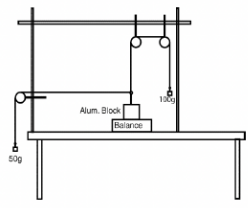Perpendicular and Parallel Forces. A 500 +/- 1 g aluminum block sits in the middle of a balance. Strings with small mass hangers are attached as shown in the diagram. The mass hanger on the right has a total mass of 100 +/- 1 g. The hanger on the left has a mass of 50 +/-0.5 g. Assume that the balance reads 400.1 +/-0.1g. 50g Alum. Block Balance 100g As before, follow the procedure in the lab manual to obtain a free body diagram and ultimately the second law equations for the aluminum block. It will be easier if you separate the x and y forces and deal with each direction individually.
Perpendicular and Parallel Forces. A 500 +/- 1 g aluminum block sits in the middle of a balance. Strings with small mass hangers are attached as shown in the diagram. The mass hanger on the right has a total mass of 100 +/- 1 g. The hanger on the left has a mass of 50 +/-0.5 g. Assume that the balance reads 400.1 +/-0.1g. 50g Alum. Block Balance 100g As before, follow the procedure in the lab manual to obtain a free body diagram and ultimately the second law equations for the aluminum block. It will be easier if you separate the x and y forces and deal with each direction individually.
Elements Of Electromagnetics
7th Edition
ISBN:9780190698614
Author:Sadiku, Matthew N. O.
Publisher:Sadiku, Matthew N. O.
ChapterMA: Math Assessment
Section: Chapter Questions
Problem 1.1MA
Related questions
Question

Transcribed Image Text:NOTE - the reaction force is not shown on the free body diagram you just drew. Do
you understand why?
Perpendicular and Parallel
Forces.
A 500 +/- 1 g aluminum block sits in
the middle of a balance. Strings with
small mass hangers are attached as
shown in the diagram. The mass
hanger on the right has a total mass of
100 +/- 1 g. The hanger on the left has a
mass of 50 +/- 0.5 g. Assume that the
balance reads 400.1 +/- 0.1g.
50g
Alum. Block
Balance
100g
As before, follow the procedure in the
lab manual to obtain a free body diagram and ultimately the second law
equations for the aluminum block. It will be easier if you separate the x and y
forces and deal with each direction individually.
When you have completed writing the second law equations above, answer the
following questions:
2. What is the magnitude of the frictional force acting between the aluminum block
and the balance? (You should be able to determine this from your free body
diagrams.)

Transcribed Image Text:3. Calculate the numeric values for the forces given. Using the second law equation
you wrote for the vertical forces, verify if the forces sum to zero within experimental
error. If not within the expected experimental error, are the values obtained out of
reason considering the apparatus and experimental arrangement?
4. You add 50 g of mass to the left mass hanger (for a total mass of 100 g), what is the
frictional force between the aluminum block and the balance?
5. Leaving the left mass hanger with a total of 100 g mass, you add 100 g of mass to
the right mass hanger (for a total mass of 200 g). What is the frictional force between
the aluminum block and the balance?
6. Using a simple sketch, identify the reaction to the normal force acting on the
aluminum block. What is its direction and magnitude compared to the normal force?
Expert Solution
Step 1
Given:

To find:
Freebody diagram
Frictional force
Trending now
This is a popular solution!
Step by step
Solved in 4 steps with 3 images

Knowledge Booster
Learn more about
Need a deep-dive on the concept behind this application? Look no further. Learn more about this topic, mechanical-engineering and related others by exploring similar questions and additional content below.Recommended textbooks for you

Elements Of Electromagnetics
Mechanical Engineering
ISBN:
9780190698614
Author:
Sadiku, Matthew N. O.
Publisher:
Oxford University Press

Mechanics of Materials (10th Edition)
Mechanical Engineering
ISBN:
9780134319650
Author:
Russell C. Hibbeler
Publisher:
PEARSON

Thermodynamics: An Engineering Approach
Mechanical Engineering
ISBN:
9781259822674
Author:
Yunus A. Cengel Dr., Michael A. Boles
Publisher:
McGraw-Hill Education

Elements Of Electromagnetics
Mechanical Engineering
ISBN:
9780190698614
Author:
Sadiku, Matthew N. O.
Publisher:
Oxford University Press

Mechanics of Materials (10th Edition)
Mechanical Engineering
ISBN:
9780134319650
Author:
Russell C. Hibbeler
Publisher:
PEARSON

Thermodynamics: An Engineering Approach
Mechanical Engineering
ISBN:
9781259822674
Author:
Yunus A. Cengel Dr., Michael A. Boles
Publisher:
McGraw-Hill Education

Control Systems Engineering
Mechanical Engineering
ISBN:
9781118170519
Author:
Norman S. Nise
Publisher:
WILEY

Mechanics of Materials (MindTap Course List)
Mechanical Engineering
ISBN:
9781337093347
Author:
Barry J. Goodno, James M. Gere
Publisher:
Cengage Learning

Engineering Mechanics: Statics
Mechanical Engineering
ISBN:
9781118807330
Author:
James L. Meriam, L. G. Kraige, J. N. Bolton
Publisher:
WILEY